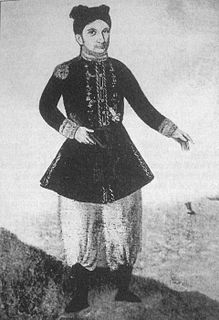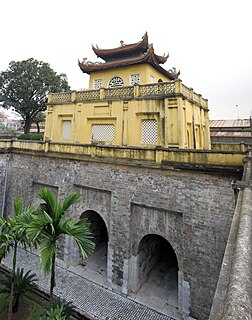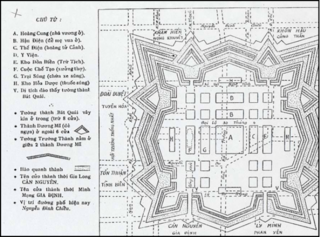 W
WArmy and warfare made their first appearance in Vietnamese history during the 3rd millennium BC. Throughout thousands of years, wars played a great role in shaping the identity and culture of people inhabited the land which is modern day Vietnam.
 W
WThe artillery of the Nguyễn lords, the family that ruled southern Vietnam from the late 16th to the late 18th centuries, and the precursor of the Nguyễn dynasty, was an important component of their military success in repelling attacks from the rival Trịnh lords, their northern contemporaries. Between 1627 and 1672, seven campaigns were waged by the Trịnh in an attempt to break the Nguyễn, without success, along a front line near the 17th parallel, which later divided North and South Vietnam, 1954 to 1975. The Nguyễn were much weaker than the Trịnh in terms of having an established state and administration, with a vastly smaller army and population from which to draw resources, but their fortification system and their superior artillery allowed them to repel attacks from a stronger enemy while at the same time pushing southwards in the Nam tiến which established Vietnam's modern-day territory.
 W
WThe Cambodian–Vietnamese War, known in Vietnam as the Counter-offensive on the Southwestern border, and by Cambodian nationalists as the Vietnamese invasion of Cambodia, was an armed conflict between Democratic Kampuchea, controlled by the Khmer Rouge, and the Socialist Republic of Vietnam. The war began with repeated attacks by the Kampuchean Revolutionary Army on the southwestern border of Vietnam, particularly the Ba Chuc massacre which resulted in the deaths of over 3,000 Vietnamese civilians. On 25 December 1978, Vietnam launched a full-scale invasion of Kampuchea, and subsequently occupied the country and removed the government of the Communist Party of Kampuchea from power.
 W
WThe Capture of Nam Định, a confrontation between the French and the Vietnamese, was one of the early engagements of the Tonkin Campaign (1883–86). In a brief campaign in the last week of March 1883, Commandant Henri Rivière captured the citadel of Nam Định, the second-largest city in Tonkin, with a flotilla of gunboats and a battalion of marine infantry.
 W
WJean-Baptiste Thomas Médée Cécille was a French Admiral and politician who played an important role in the French intervention of Vietnam. He also circumnavigated the globe.
 W
WJean-Baptiste Chaigneau (1769–1832) was a French Navy sailor and an adventurer who played an important role in Vietnam in the 19th century. He served the Nguyễn Dynasty from 1794 to 1819, and 1821 to 1826, and took the Vietnamese name of Nguyễn Văn Thắng (阮文勝).
 W
WThe Citadel of Saigon also known as the Citadel of Gia Định was a late 18th-century fortress that stood in Saigon, Vietnam from its construction in 1790 until its destruction in February 1859. The citadel was only used once prior to its destruction, when it was captured by Lê Văn Khôi in 1833 and used in a revolt against Emperor Minh Mạng. It was destroyed in a French naval bombardment as part of the colonization of southern Vietnam which became the French colony of Cochinchina.
 W
WThe Đại Việt–Khmer Wars were a series of wars fought between the kingdom of Đại Việt and the Khmer Empire between 1123 and 1150.
 W
WĐống Đa Mound or Đống Đa Hill is a historic tumulus-like mound in the Đống Đa Park, in the Đống Đa District, Hanoi, Vietnam.
 W
WGeneral Jacques Charles René Achille Duchesne was a 19th-century French military officer. He was born at Sens and entered Saint-Cyr in 1855, aged 18, and became a lieutenant in 1861.
 W
WFrench assistance to Nguyễn Phúc Ánh, the future Emperor of Vietnam and the founder of the Nguyễn Dynasty, covered a period from 1777 to 1820. From 1777, Mgr Pigneau de Behaine, of the Paris Foreign Missions Society, had taken to protecting the young Vietnamese prince who was fleeing from the offensive of the Tây Sơn. Pigneau de Behaine went to France to obtain military aid, and secured a France-Vietnam alliance that was signed through the 1787 Treaty of Versailles between the king of France, Louis XVI, and Prince Nguyễn Phúc Ánh. As the French regime was under considerable strain at the eve of the French Revolution, France was unable to follow through with the application of the treaty. However, Mgr Pigneau de Behaine persisted in his efforts and, with the support of French individuals and traders, mounted a force of French soldiers and officers that would contribute to the modernization of the armies of Nguyễn Ánh, making possible his victory and his reconquest of all of Vietnam by 1802. A few French officers would remain in Vietnam after the victory, becoming prominent mandarins. The last of them left in 1824 following the enthronement of Minh Mạng, Gia Long's successor. The terms of the 1787 Treaty of Alliance would still remain one of the justifications of French forces when they demanded the remittance of Đà Nẵng in 1847.
 W
WThe Poisoning at Hanoi Citadel was a poisoning plot which occurred in 1908 when a group of Vietnamese indigenous tirailleurs attempted to poison the entire French colonial army's garrison in the Citadel of Hanoi. The aim of the plot was to neutralize the French garrison and make way for Hoang Hoa Tham's rebel army to capture Hanoi. The plot was disclosed, and then was suppressed by the French.
 W
WThe Imperial Citadel of Thăng Long is a complex of historic imperial buildings located in the centre of Hanoi, Vietnam. It is also known as Hanoi Citadel.
 W
WThe Johnson South Reef Skirmish was an altercation that took place on 14 March 1988 between Chinese and Vietnamese forces over who would annex the Johnson South Reef in the Union Banks region of the Spratly Islands in the South China Sea.
 W
WThe Lê Văn Khôi revolt was an important revolt in 19th-century Vietnam, in which southern Vietnamese, Vietnamese Catholics, French Catholic missionaries and Chinese settlers under the leadership of Lê Văn Khôi opposed the Imperial rule of Emperor Minh Mạng.
 W
WMông Đồng 艨艟 is a class of near-shore warship and riverine boat that played a dominant role in medieval Vietnamese naval forces for over a thousand years.
 W
WArmy and warfare made their first appearance in Vietnamese history during the 3rd millennium BC. Throughout thousands of years, wars played a great role in shaping the identity and culture of people inhabited the land which is modern day Vietnam.
 W
WVictor Olivier de Puymanel, Nguyễn Văn Tín (阮文信) or Ông Tín in Vietnamese, was a French construction officer and a French Navy volunteer and adventurer who had an important role in Vietnam in the 18th and 19th century. He played a key role in the modernization of the army of Nguyễn Phúc Ánh.
 W
WThe 1841–1845 Siamese-Vietnamese War in Cambodia was a military conflict between Đại Nam (Vietnam), ruled by the Nguyen emperor Thiệu Trị and the Kingdom of Siam under the rule of Chakkri king Nangklao. The rivalry between Vietnam and Siam over the control of the Cambodian heartlands in the Lower Mekong basin had intensified after Siam's failed attempt to conquer Cambodia during the previous war from 1831 until 1834. Nguyen Emperor Minh Mạng installed Princess Ang Mey to rule Cambodia as puppet queen regnant of his choice in 1834, declaring full suzerainty over Cambodia, which he thereby demoted to become Vietnam's thirty-second province, the Western Commandery. In 1841 Siam seized the opportunity of discontent and a Khmer revolt against Vietnamese rule and King Rama III sent an army to enforce Prince Ang Duong's installation as King of Cambodia. After four years of attritional struggle, both parties agreed to a compromise peace and placed Cambodia under joint rule.
 W
WThe Siamese–Vietnamese wars were a series of armed conflicts between the Siamese Ayutthaya Kingdom and Rattanakosin Kingdom and the various dynasties of Vietnam mainly during the 18th and 19th centuries. Several of the wars took place in modern-day Cambodia.
 W
WThe Tirailleurs indochinois were soldiers of several regiments of local ethnic Indochinese infantry organized as Tirailleurs by the French colonial authorities, initially in Vietnam from 15 March 1880. The most notable, and first established, of these units were the Tonkinese Rifles.
 W
WThe Siege of Tourane was a Vietnamese victory during the Cochinchina Campaign, a punitive campaign against the Vietnamese launched by France and Spain in 1858. A joint Franco-Spanish expedition under the command of Admiral Charles Rigault de Genouilly captured Tourane in September 1858, but was then besieged in the city by the Vietnamese and forced eventually to evacuate it in March 1860.
 W
WOn March 8, 1949, after the Élysée Accords, the State of Vietnam was recognized by France as an independent country ruled by Vietnamese Emperor Bảo Đại. The Vietnamese National Army or Vietnam National Army was the State of Vietnam's military force created shortly after that. It was commanded by Vietnamese General Hinh and was loyal to Bảo Đại. The VNA fought in joint operations with the French Union's French Far East Expeditionary Corps (CEFEO) against the communist Việt Minh forces led by Ho Chi Minh. Different units within the VNA fought in a wide range of campaigns including the Battle of Nà Sản (1952), Operation Hautes Alpes (1953), Operation Atlas (1953) and the Battle of Dien Bien Phu (1954).
 W
WThe War in Vietnam, codenamed Operation Masterdom by the British, and also known as Nam Bộ kháng chiến by the Vietnamese, was a post–World War II armed conflict involving a largely British-Indian and French task force and Japanese troops from the Southern Expeditionary Army Group, versus the Vietnamese communist movement, the Viet Minh, for control of the southern half of the country, after the unconditional Japanese surrender.
 W
WThe 1954 to 1959 phase of the Vietnam War was the era of the two nations. Coming after the First Indochina War, this period resulted in the military defeat of the French, a 1954 Geneva meeting that partitioned Vietnam into North and South, and the French withdrawal from Vietnam, leaving the Republic of Vietnam regime fighting a communist insurgency with USA aid. During this period, North Vietnam recovered from the wounds of war, rebuilt nationally, and accrued to prepare for the anticipated war. In South Vietnam, Ngô Đình Diệm consolidated power and encouraged anti-communism. This period was marked by U.S. support to South Vietnam before Gulf of Tonkin, as well as communist infrastructure-building.
 W
WThe Yên Bái mutiny was an uprising of Vietnamese soldiers in the French colonial army on 10 February 1930 in collaboration with civilian supporters who were members of the Việt Nam Quốc Dân Đảng.